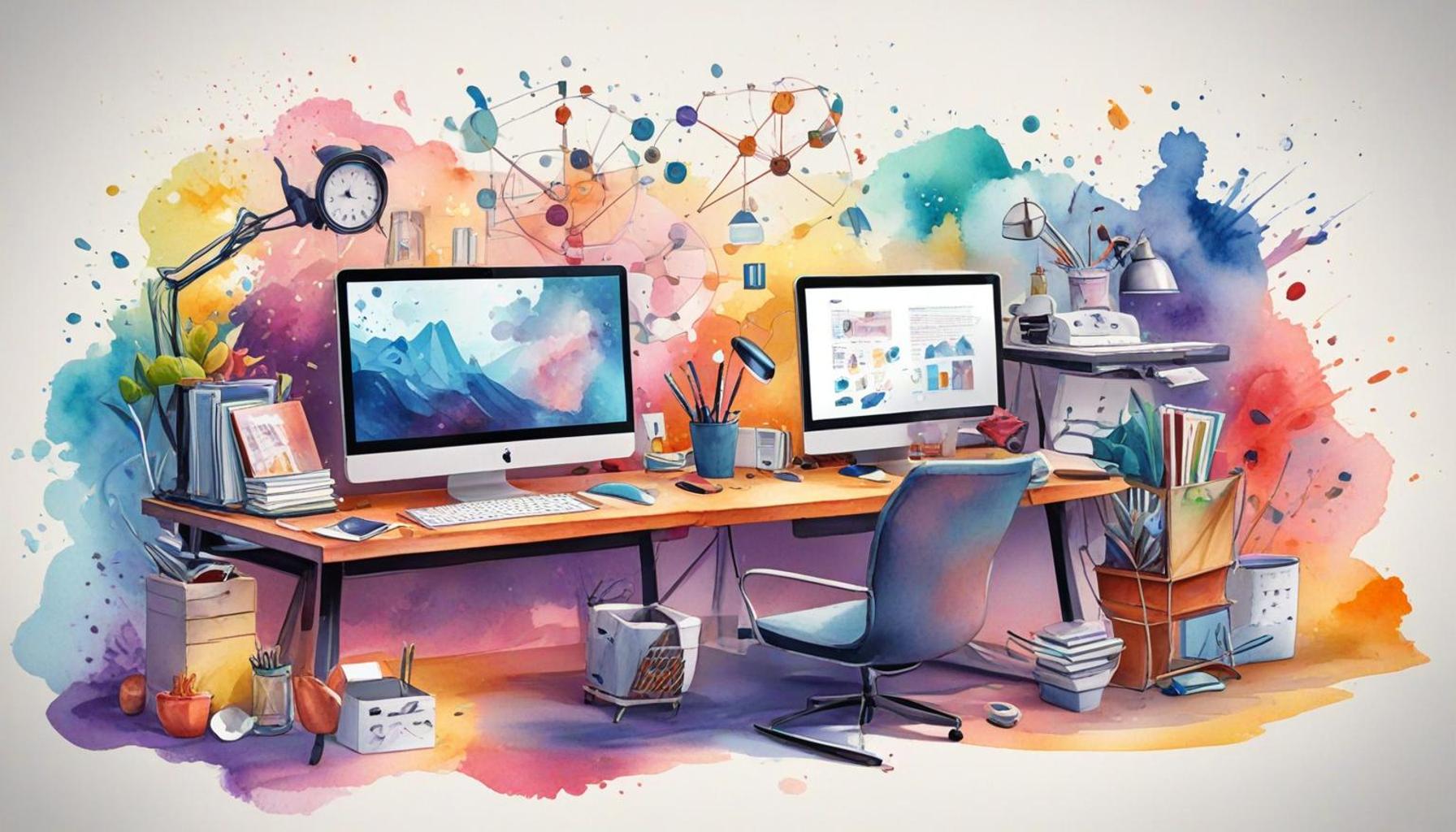Organization Strategies for Shared Spaces: How Minimalism Can Increase Efficiency

Transforming Shared Spaces
In today’s fast-paced work environment, shared spaces are increasingly common, yet they often descend into chaos. This clutter not only stifles productivity but can also lead to heightened stress among team members. Here is where minimalism emerges as a powerful ally, offering a structured pathway to enhance both organization and efficiency in these environments. By embracing minimalist principles, individuals and teams can cultivate harmonious workspaces that promote focus, creativity, and collaboration.
The Benefits of Minimalism
- Reduced Clutter: The primary benefit of minimalism is the elimination of excess items. Each piece in the workspace should serve a purpose, resulting in a cleaner, focused atmosphere that minimizes distractions. For example, instead of cluttering desks with unnecessary paperwork, digital tools such as cloud storage can simplify document management.
- Enhanced Clarity: A minimalist approach does more than just streamline physical space; it fosters a clearer mindset. With fewer distractions, employees can concentrate more effectively, leading to improved decision-making and efficiency. Research indicates that environments characterized by minimalism can enhance cognitive function, making it easier to tackle complex projects.
- Increased Functionality: Minimalism emphasizes functionality, ensuring a more intuitive workspace. By keeping essential resources easily accessible and organized, teams can navigate their tasks with greater ease and less frustration. For instance, a shared kitchen space can utilize labeled storage bins to ensure everyone knows where to find snacks or utensils without rummaging through drawers.
Creating a productive work environment involves more than just the right furniture and technology; it necessitates a thoughtful design tailored to nurture creativity and enhance collaboration. Here are some key strategies:
- Smart Storage Solutions: By utilizing vertical space, such as wall-mounted shelves, teams can maximize their workspace while keeping surfaces clear. This approach not only reduces clutter but also creates an illusion of a more spacious area.
- Flexible Layouts: Incorporating adaptable areas allows teams to shift based on specific project needs. For instance, movable furniture can easily transform a meeting space into a brainstorming zone, accommodating diverse collaboration styles.
- Intentional Design Elements: Instead of overwhelming spaces with decorations, select a few purposeful elements that inspire. A single piece of artwork or a motivational quote can serve as a focal point, providing inspiration without creating distraction.
Implementing these strategies can dramatically transform any shared space into a center of efficiency and creativity. The journey towards an organized, minimalist environment not only benefits individual productivity but also nurtures a collaborative spirit essential for team success. As work styles continue to evolve in the United States, reevaluating how we design our shared spaces could lead to thriving, innovative workplaces where every member feels empowered to contribute their best work.
DISCOVER MORE: Click here to learn how minimalism can enhance your time management
Implementing Minimalist Principles in Shared Spaces
Creating a minimalist environment in shared spaces is more than just a trend; it’s a strategic approach to increase efficiency and productivity. As companies strive for innovative solutions to their workspace challenges, minimalism emerges as a practical answer, enabling organizations to maximize the utility of every square foot. Here are some essential strategies that highlight how to implement these principles effectively.

Assessing the Current State
Before diving into reorganizing a shared space, it’s crucial to assess its current condition. This involves evaluating what items are occupying valuable real estate and determining their relevance. Engage team members to bring forward their insights as they are the primary users of the space. Conduct a space audit, identifying items that are no longer in use or have outlived their purpose, ensuring that only items that contribute to productivity remain.
Establishing Guidelines
Creating clear guidelines for maintaining minimalism is essential for long-term success. These rules should include:
- One In, One Out: Encourage a policy where for every new item brought into the workspace, an existing item must be removed. This ensures that clutter does not build up over time.
- Defined Zones: Designate specific areas for distinct activities, such as workstations, relaxation spots, and meeting areas. This helps in reducing the mingling of purposes that can lead to disorganization.
- Regular Decluttering: Schedule routine decluttering sessions as a part of team meetings or activities to evaluate what remains essential. Involve everyone to foster a collective responsibility for maintaining a clean environment.
Leveraging Technology
In the age of digital advancement, utilizing technology can significantly aid in achieving minimalism. Transitioning to digital solutions for document storage and communication can dramatically decrease physical clutter. Cloud-based tools not only reduce the need for paper but also streamline access to information, creating an organized flow of work. Collaboration platforms can centralize discussions and updates, eliminating the need for sticky notes, paper memos, or numerous printouts that clutter workspaces.
In addition to the organizational benefits, these strategies align with the growing environmental consciousness prevalent in corporate America. By adopting minimalist practices, organizations contribute to a more sustainable future while enhancing their internal efficiency. This connection between minimalism and environmental responsibility resonates well with modern employees, fostering a sense of pride in their workspace and company values.
Through the thoughtful implementation of these strategies, shared spaces can transform from chaotic environments into bastions of productivity. Minimalism offers a pathway not only to better organization but also to a renewed sense of purpose and collaboration, leaving room for creativity to flourish amidst the simplicity.
| Advantage | Explanation |
|---|---|
| Enhanced Focus | A minimalist environment reduces distractions, allowing individuals to concentrate better on tasks, thereby boosting productivity. |
| Streamlined Collaboration | Fewer items and organized spaces encourage efficient teamwork, as it’s easier to communicate and share ideas in a decluttered area. |
| Improved Space Utilization | Minimalism often leads to better resource management, ensuring that every square foot is used effectively for its purpose. |
| Stress Reduction | A clean, organized space can significantly lower stress levels, making shared environments more pleasant and improving overall morale. |
Exploring these advantages demonstrates how integral minimalism is for transforming shared spaces into hubs of efficiency and productivity. By focusing on fewer distractions, enhancing collaboration, making better use of space, and reducing stress, organizations can create environments that not only foster creativity but also empower individuals to achieve their best work. As businesses consider adopting minimal strategies, they might find that simplifying their surroundings results in profound benefits, clearing pathways to innovative ideas and collaboration.
DISCOVER MORE: Click here for smart organization tips
Enhancing Collaboration through Minimalism
Minimalism in shared spaces extends beyond mere aesthetics; it fundamentally influences how teams collaborate and innovate. In office environments, clutter can be a silent productivity killer. Research indicates that a disorganized workspace can lead to feelings of overwhelm, which ultimately stifles creativity and morale among team members. By streamlining surroundings, organizations can promote focused work and facilitate meaningful interactions. Here are several strategies to enhance collaboration through minimalist practices.
Designing Functional Furniture
The furniture choices made for shared spaces play a pivotal role in fostering collaboration while adhering to minimalist principles. Opting for multifunctional furniture can significantly reduce clutter while enhancing efficiency. For instance, modular desks that can be easily reconfigured for individual work or collaborative sessions allow teams the flexibility to adapt their space according to their immediate needs. Additionally, seating that combines comfort with style can create inviting areas for informal brainstorming, helping to reinforce teamwork and communication.
Utilizing Open Layouts
Open layouts naturally encourage interaction, but they require careful planning to avoid chaos. By thoughtfully organizing open concepts with designated gathering spots and quiet zones, organizations can balance collaboration and concentration. Simple additions like movable partitions can provide privacy when necessary while still enabling a fluid transition for discussions or creative brainstorming when needed. Such spaces not only enhance communication but also instill a sense of community among employees.
Encouraging Simplicity in Communication
In a digitally driven workplace, the philosophy of minimalism should extend to communication channels as well. Over-relying on multiple platforms can lead to confusion and information overload. Encourage teams to adopt a primary communication tool and streamline updates. Using simple, straightforward methods—like visual dashboards or concise email updates—can reduce the time spent sifting through unnecessary information and keep everyone aligned. Adopting clear communication guidelines helps clarify purpose and context, making collaboration much more efficient.
Fostering a Culture of Minimalism
For minimalism to take root in shared spaces, it must be ingrained in the organization’s culture. Leaders can play a significant role by embodying minimalist behavior in their interactions and decision-making processes. Regular workshops or discussions on the benefits of minimalism can underline its importance and motivate teammates to embrace it. Recognizing and rewarding teams who successfully maintain a decluttered, organized environment fosters a sense of accountability and inspiration. Moreover, involving employees in the design process encourages buy-in and ownership of the company’s workspace adjustments.
Studies suggest that organizations that prioritize a minimalist philosophy tend to have employees who report higher levels of job satisfaction and engagement. By investing in shared spaces that embody minimalism, companies can cultivate creativity and collaboration, essential components for innovation in today’s competitive market. Ultimately, a commitment to minimizing clutter not only promotes operational efficiency but also enhances the overall employee experience within the organization.
DISCOVER MORE: Click here to uncover the keys to minimalist lifestyle success
Conclusion: The Power of Minimalism in Shared Spaces
In an era where collaboration and efficiency are paramount, embracing minimalism in shared spaces offers a pathway to not only enhance productivity but also elevate employee engagement. By prioritizing functional designs, such as modular furniture that adapts to various team dynamics, organizations can eliminate the clutter that hampers creativity and cohesion. Open layouts, thoughtfully organized to provide both collaborative zones and quiet spaces, foster a culture of communication while maintaining the serenity necessary for concentration.
Moreover, a streamlined approach to communication, coupled with a culture that champions simplicity and minimalism, can drastically reduce overwhelm and encourage clarity among team members. These strategies illustrate the transformative potential of minimalism, as they lead to an atmosphere that inspires innovation and connection. Organizations that integrate these principles tend to witness not just improvements in efficiency but also a noticeable uplift in overall job satisfaction and morale.
As businesses continue to adapt to the constantly evolving landscape of work, it is imperative for leaders to consider the role that shared spaces play in shaping the organizational experience. By investing in minimalism, companies are not only optimizing operations; they are cultivating a vibrant community where creativity thrives. As you reflect on your own work environment, ask yourself: how can the principles of minimalism shape the future of your shared spaces and ultimately drive success in your organization?



